Table of contents
- Patent drawings Yamaha MT-Turbo Patent shows Yamaha with three-cylinder turbo
- What is downsizing? And what’s the point?
- Turbo use in MT-10 and FJR 1300?
- Turbo as a replacement for complicated technology
- Patent means development
- Conclusion
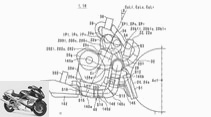
Yamaha Europe
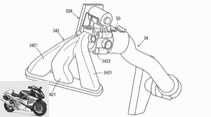



5 pictures
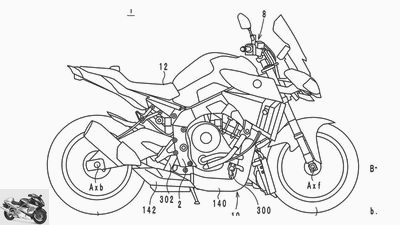
Yamaha Europe
1/5
Yamaha MT-Turbo? Visually, the experimental engine seems to be planted in the chassis of an MT; the thick downpipe of Turbo # 140, in which two catalytic converters are already installed, is easy to see. The oil cooler next to the front wheel is still disturbing.
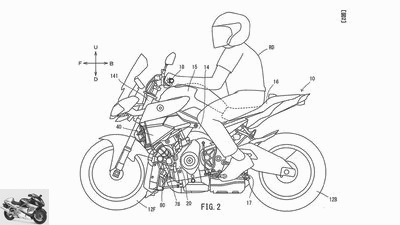
Yamaha Europe
2/5
With the water cooler under the turbo, almost next to the motorcycle, the system should achieve top values in terms of cooling. Visually and aerodynamically but difficult to argue.
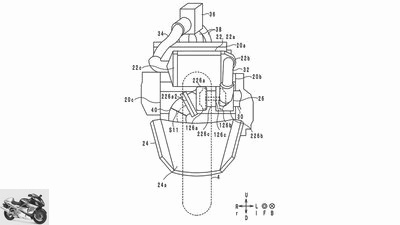
Yamaha Europe
3/5
Top view from the front: The turbo # 126/226 sits very close to the cylinder head, which does not make the exhaust gas routing to the charger easy and also causes the temperature in the turbo to rise, which in turn necessitates the use of a charge air cooler # 22.

Yamaha Europe
4/5
Intake manifold after intercooler # 34 with direct connection to throttle valve # 50 and a fanned intake bridge. The lack of injection into the intake air speaks in favor of gasoline direct injection into the combustion chamber, which provides high fuel-saving potential, especially in the partial load range.
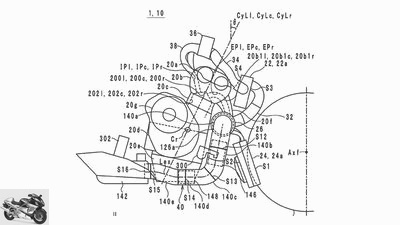
Yamaha Europe
5/5
It is easy to see the two catalysts in the exhaust pipe in the direction of the collector.
counselor
technology & future
Yamaha patent for three-cylinder turbo
Patent drawings Yamaha MT-Turbo
Patent shows Yamaha with three-cylinder turbo
With the patent drawings of a Yamaha with turbo that have emerged, even the wildest increases in performance sprout skyward. Here and there is speculated of up to 180 hp and 170 Nm from a displacement of 850 cm³. But what if Yamaha used the turbo better?
Jens Kratschmar
December 28, 2020
Imagine you had a turbo in your motorcycle and only 2.5 liters of fuel consumption. That is what the patent drawings of the Yamaha Turbos off? No, but they also don’t talk about an incredible amount of performance. So what if Yamaha were to use the turbo as the automobile manufacturers have for years: namely for downsizing and for simplification. Patent drawings show a three-cylinder engine with turbo and charge air cooling. Perceived displacement: 800 to 850 cm³.
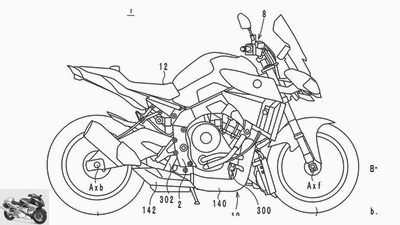
Yamaha Europe
Yamaha MT-Turbo? Visually, the experimental engine seems to be planted in the chassis of an MT; the thick downpipe of Turbo # 140, in which two catalytic converters are already installed, is easy to see. The oil cooler next to the front wheel is still disturbing.
What is downsizing? And what’s the point?
Put simply, downsizing is a method of giving a vehicle with a new, smaller engine the same performance as before. This is usually done using a turbocharger. The result: a smaller displacement with reduced displacement-specific consumption, the same output and power as with the larger displacement and, to a certain extent, a lower weight of the drive. While 150 hp came from a 2.0 liter displacement in the car before, 1.5 liters are sufficient with the turbo with the same power and a broader rev range, which in turn is beneficial for consumption.
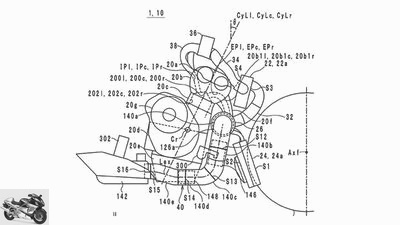
Yamaha Europe
It is easy to see the two catalysts in the exhaust pipe in the direction of the collector.
Turbo use in MT-10 and FJR 1300?
Let’s transfer that to two Yamaha models, which currently have a comparatively large displacement, a lot of power and sometimes a good thirst. For example on the Yamaha MT-10. Great engine, but also thirsty in practice. Currently 998 cm³ displacement with 160 HP power, 111 Nm torque and with a proud eight liters consumption per 100 km. Or the big one FJR with the big 1300 in-line quad, with almost antique charm: 147 hp, 138 Nm and 6.2 liter consumption. Suppose Yamaha is looking for the MT-10 or one “new” FJR 1300 a new, more economical engine. A three-cylinder with a small displacement, long stroke and turbo would be a logical choice. The target-oriented result could be: 850 cc displacement with a lot of torque and a comparatively low speed level – the latter with regard to upcoming emission limits. Numbers could be: 120 to 130 Nm torque, which is available from 3,500 tours with a nominal speed of 8,500 tours. That would also make 160 hp again. Which would mean more power for an FJR and ten to 20 Nm more torque for an MT-10. And that with a reduction in displacement of 35 and 15 percent and correspondingly lower fuel consumption.
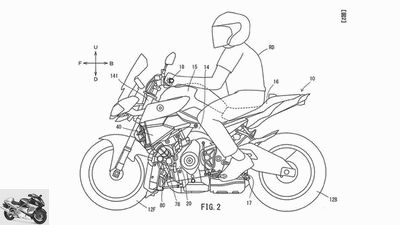
Yamaha Europe
With the water cooler under the turbo, almost next to the motorcycle, the system should achieve top values in terms of cooling. Optics and aerodynamics but difficult to argue.
Turbo as a replacement for complicated technology
Another advantage of turbo technology can be that Yamaha would like to avoid the development of highly complicated, variable valve controls for certain engines, because theoretically a turbo does not care about timing, valve lifts and so on. It simply pushes into the intake duct, the valve opens and the air is pushed into the combustion chamber. But it is precisely this way of working that leaves room for speculation that precisely such a technology with variable timing or even valve lifts in combination with gasoline direct injection can come about.
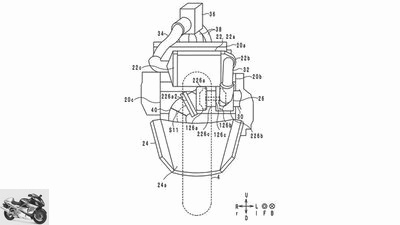
Yamaha Europe
Top view from the front. The turbo # 126/226 sits very close to the cylinder head, which makes it difficult to route the exhaust gas to the charger and also increases the temperature in the turbo, which makes the use of a charge air cooler # 22 necessary.
Patent means development
As the drawings show, a patent is often very far from an approaching production. At Yamaha, the water cooling system in particular is still very adventurous next to the motorcycle and also the use of one “old” Delta box frame is probably far from being the final version. For both construction sites, a frame construction would be the same as the current one V4 from Ducati or the brand new one Tesi from Bimota with a powerful engine with a subframe is effective.
Conclusion
Compressors, turbos, downsizing. All terms from the automotive industry of the past decade and now probably more present than ever in motorcycle construction. The only thing missing is electric compressors. Seriously: Euro 6 and everything after that poses major hurdles for motorcycle manufacturers. And if you want to continue building combustion engines, well-functioning methods from four-wheel construction have to be adapted.
Related articles
-
Suzuki patent for 650 cc parallel twin with turbo
Suzuki 19th pictures Suzuki 1/19 This is what the XE7 engine looked like as a 2013 and 2015 design study. The basic architecture of the turbo system has…
-
Aprilia tricycle patent: attack on Yamaha Niken?
News 2022 New motorcycle items for 2022 Aprilia 6th pictures Aprilia 1/6 Newly emerged patent drawings show an Aprilia with two front wheels. Aprilia 2/6…
-
Kawasaki 12th pictures BMW 1/12 Norbert Klauer (58), Head of Powertrain Development at BMW Motorrad, on the possibilities and difficulties of the…
-
Generation comparison Yamaha FZS 600 Fazer-FZ6 Fazer-S2
Jahn 15th pictures Yamaha 1/15 Yamaha 2/15 Yamaha 3/15 Yamaha 4/15 Yamaha 5/15 Yamaha 6/15 The slightly more complex S2 version of the Fazer has 98 hp as…
-
Second-hand advice: Yamaha FZS 1000 Fazer, FZ1 Fazer, FZ1
archive counselor Used purchase Second-hand advice: Yamaha FZS 1000 Fazer, FZ1 Fazer, FZ1 Second-hand advice: Yamaha FZS 1000 Fazer, FZ1 Fazer, FZ1 Buy…
-
Middle class bikes from Yamaha, Kawasaki, Suzuki and Honda
fact 27 pictures fact 1/27 Comparison of mid-range motorcycles from Yamaha XJ6 Diversion F, Kawasaki ER-6f, Suzuki GSX 650 F and Honda CBF 600 S. fact…
-
Second-hand advice on turbo motorcycles
counselor Used purchase Second-hand advice on turbo motorcycles Second-hand advice on turbo motorcycles Company hot air The heated start to…
-
Premiere Yamaha YZF-R1 + videos
Yamaha 33 pictures Yamaha 1/33 First of all, we will take a look at the device: The variant with a red painted frame looks particularly elegant. Yamaha…
-
archive 24 pictures archive 1/24 35 years ago, the SR 500 marked the opposite pole of the performance craze with its half-liter single. Yamaha 2/24 35…
-
Yamaha 2022: Crosser from 50 to 450 cubic meters
Yamaha Europe 26 pictures Yamaha Europe 1/26 Yamaha PW 50 2022. Yamaha Europe 2/26 Yamaha PW 50 2022. Yamaha Europe 3/26 Yamaha TTR 110 2022. Yamaha…